Critical Analysis: Evolution, Policies, and Impact of UK Police Force
VerifiedAdded on 2020/11/23
|6
|1313
|274
Report
AI Summary
This report provides a critical analysis of the human services sector, specifically focusing on the emergence and development of the police force in the United Kingdom. It traces the historical roots of the police force, starting from its inception in London and its subsequent evolution, including key milestones such as the Metropolitan Police Act of 1829. The report examines changes in policy, professional status, power, education, and influence within the police force, detailing the impact of various acts of parliament and training frameworks. It also highlights the achievements of the police force in terms of crime reduction and maintaining public order. The report concludes with recommendations for further improvement, suggesting the adoption of advanced technologies and best practices from other countries to enhance the efficiency and effectiveness of the UK law enforcement.
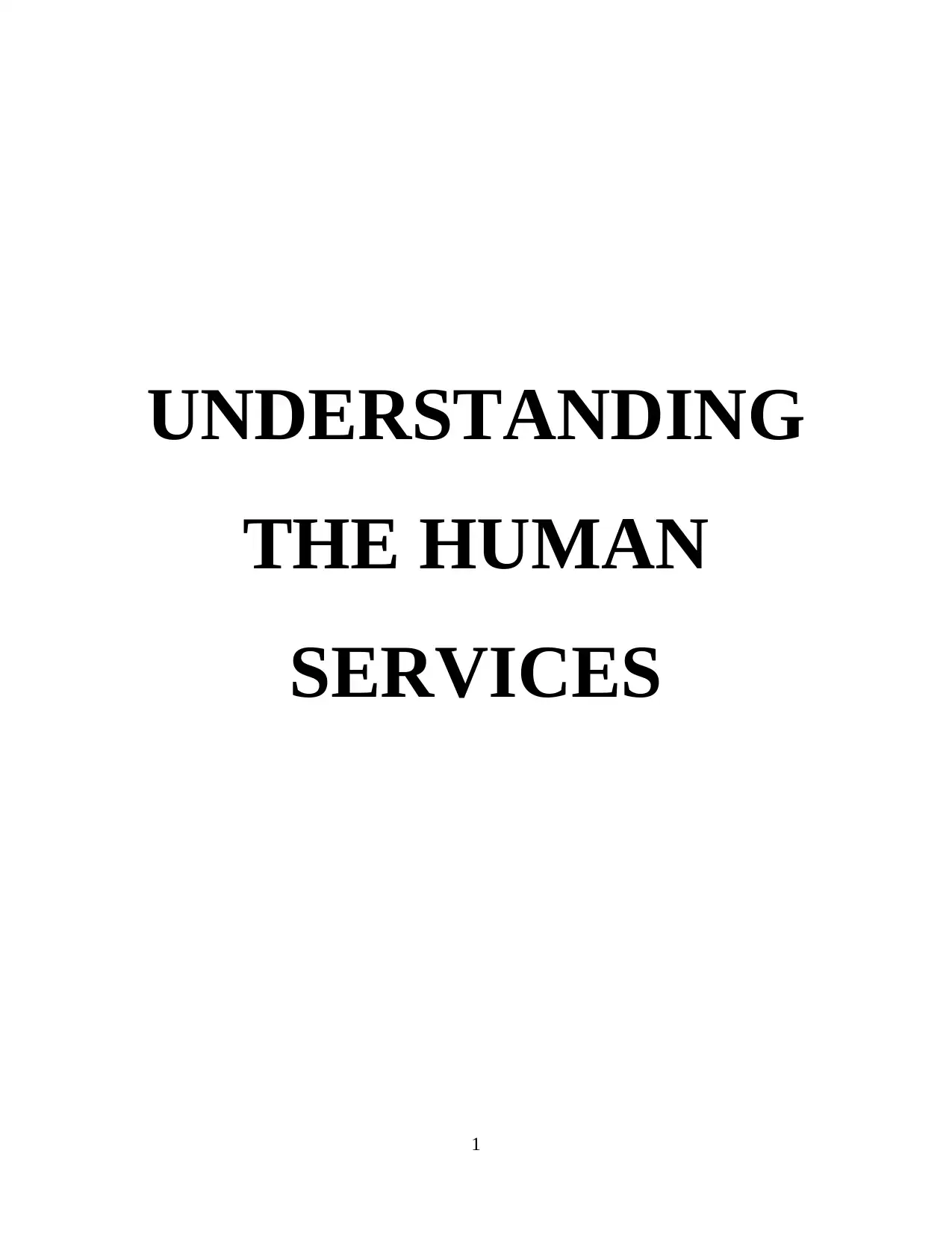
UNDERSTANDING
THE HUMAN
SERVICES
1
THE HUMAN
SERVICES
1
Paraphrase This Document
Need a fresh take? Get an instant paraphrase of this document with our AI Paraphraser
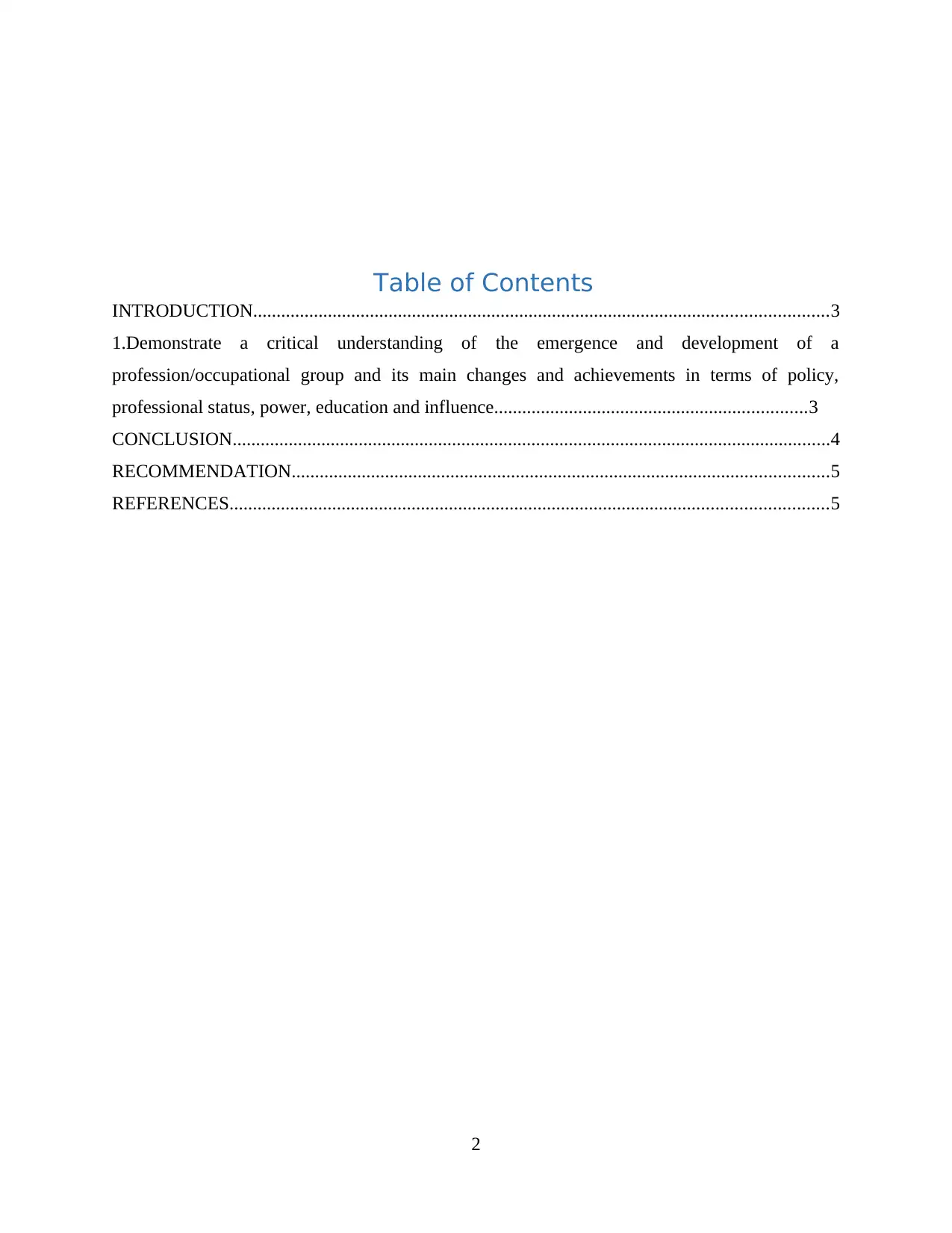
Table of Contents
INTRODUCTION...........................................................................................................................3
1.Demonstrate a critical understanding of the emergence and development of a
profession/occupational group and its main changes and achievements in terms of policy,
professional status, power, education and influence...................................................................3
CONCLUSION................................................................................................................................4
RECOMMENDATION...................................................................................................................5
REFERENCES................................................................................................................................5
2
INTRODUCTION...........................................................................................................................3
1.Demonstrate a critical understanding of the emergence and development of a
profession/occupational group and its main changes and achievements in terms of policy,
professional status, power, education and influence...................................................................3
CONCLUSION................................................................................................................................4
RECOMMENDATION...................................................................................................................5
REFERENCES................................................................................................................................5
2
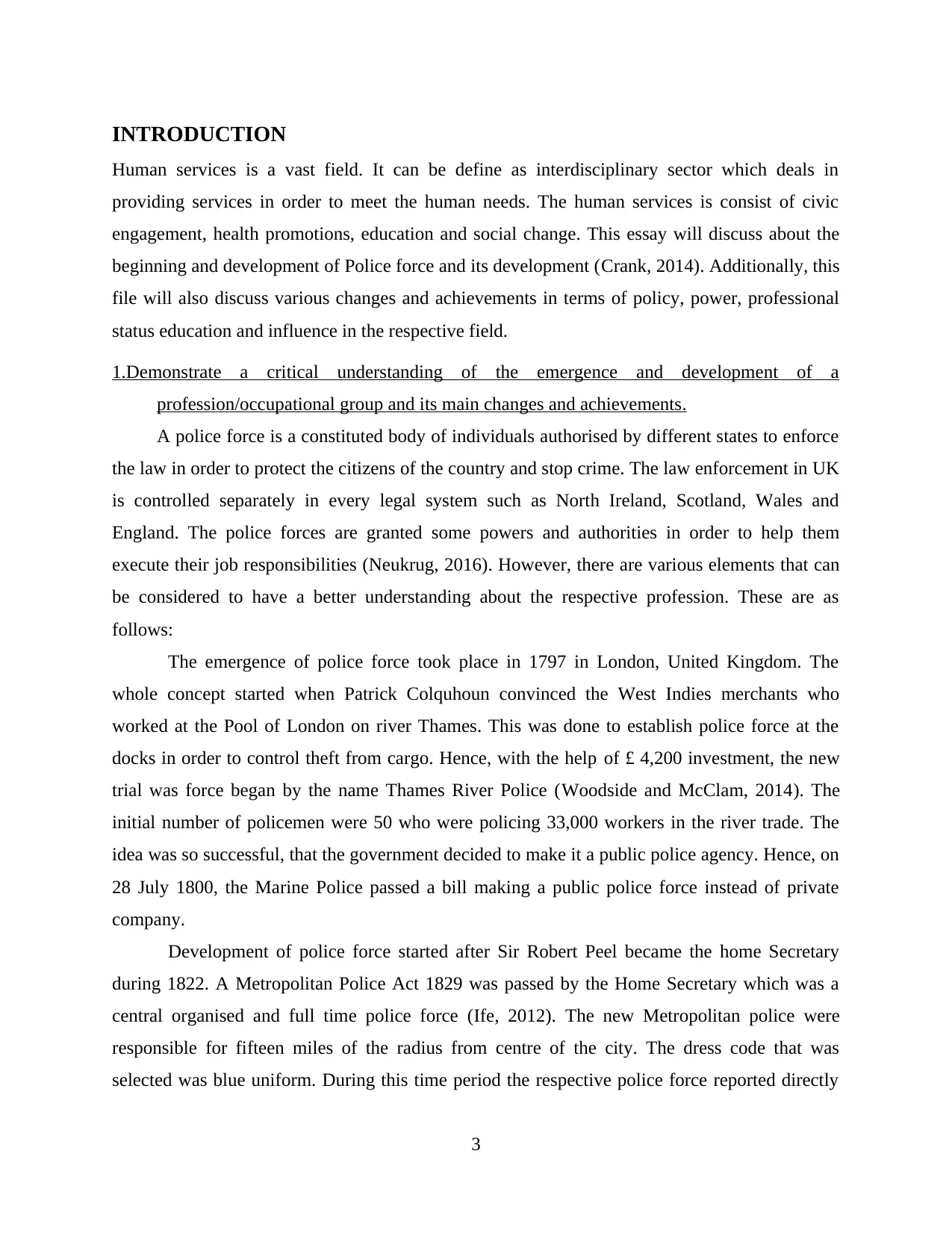
INTRODUCTION
Human services is a vast field. It can be define as interdisciplinary sector which deals in
providing services in order to meet the human needs. The human services is consist of civic
engagement, health promotions, education and social change. This essay will discuss about the
beginning and development of Police force and its development (Crank, 2014). Additionally, this
file will also discuss various changes and achievements in terms of policy, power, professional
status education and influence in the respective field.
1.Demonstrate a critical understanding of the emergence and development of a
profession/occupational group and its main changes and achievements.
A police force is a constituted body of individuals authorised by different states to enforce
the law in order to protect the citizens of the country and stop crime. The law enforcement in UK
is controlled separately in every legal system such as North Ireland, Scotland, Wales and
England. The police forces are granted some powers and authorities in order to help them
execute their job responsibilities (Neukrug, 2016). However, there are various elements that can
be considered to have a better understanding about the respective profession. These are as
follows:
The emergence of police force took place in 1797 in London, United Kingdom. The
whole concept started when Patrick Colquhoun convinced the West Indies merchants who
worked at the Pool of London on river Thames. This was done to establish police force at the
docks in order to control theft from cargo. Hence, with the help of £ 4,200 investment, the new
trial was force began by the name Thames River Police (Woodside and McClam, 2014). The
initial number of policemen were 50 who were policing 33,000 workers in the river trade. The
idea was so successful, that the government decided to make it a public police agency. Hence, on
28 July 1800, the Marine Police passed a bill making a public police force instead of private
company.
Development of police force started after Sir Robert Peel became the home Secretary
during 1822. A Metropolitan Police Act 1829 was passed by the Home Secretary which was a
central organised and full time police force (Ife, 2012). The new Metropolitan police were
responsible for fifteen miles of the radius from centre of the city. The dress code that was
selected was blue uniform. During this time period the respective police force reported directly
3
Human services is a vast field. It can be define as interdisciplinary sector which deals in
providing services in order to meet the human needs. The human services is consist of civic
engagement, health promotions, education and social change. This essay will discuss about the
beginning and development of Police force and its development (Crank, 2014). Additionally, this
file will also discuss various changes and achievements in terms of policy, power, professional
status education and influence in the respective field.
1.Demonstrate a critical understanding of the emergence and development of a
profession/occupational group and its main changes and achievements.
A police force is a constituted body of individuals authorised by different states to enforce
the law in order to protect the citizens of the country and stop crime. The law enforcement in UK
is controlled separately in every legal system such as North Ireland, Scotland, Wales and
England. The police forces are granted some powers and authorities in order to help them
execute their job responsibilities (Neukrug, 2016). However, there are various elements that can
be considered to have a better understanding about the respective profession. These are as
follows:
The emergence of police force took place in 1797 in London, United Kingdom. The
whole concept started when Patrick Colquhoun convinced the West Indies merchants who
worked at the Pool of London on river Thames. This was done to establish police force at the
docks in order to control theft from cargo. Hence, with the help of £ 4,200 investment, the new
trial was force began by the name Thames River Police (Woodside and McClam, 2014). The
initial number of policemen were 50 who were policing 33,000 workers in the river trade. The
idea was so successful, that the government decided to make it a public police agency. Hence, on
28 July 1800, the Marine Police passed a bill making a public police force instead of private
company.
Development of police force started after Sir Robert Peel became the home Secretary
during 1822. A Metropolitan Police Act 1829 was passed by the Home Secretary which was a
central organised and full time police force (Ife, 2012). The new Metropolitan police were
responsible for fifteen miles of the radius from centre of the city. The dress code that was
selected was blue uniform. During this time period the respective police force reported directly
3
⊘ This is a preview!⊘
Do you want full access?
Subscribe today to unlock all pages.

Trusted by 1+ million students worldwide
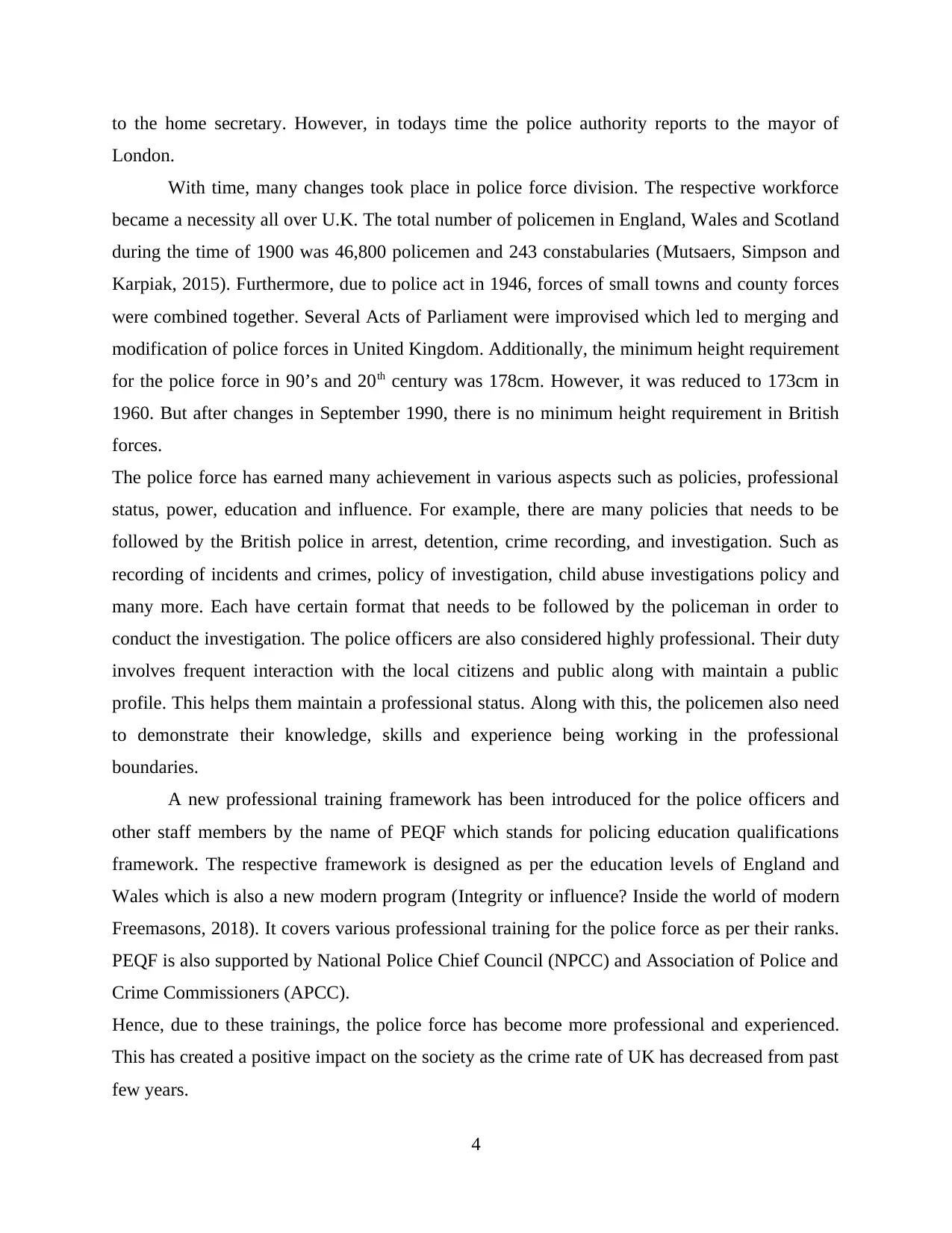
to the home secretary. However, in todays time the police authority reports to the mayor of
London.
With time, many changes took place in police force division. The respective workforce
became a necessity all over U.K. The total number of policemen in England, Wales and Scotland
during the time of 1900 was 46,800 policemen and 243 constabularies (Mutsaers, Simpson and
Karpiak, 2015). Furthermore, due to police act in 1946, forces of small towns and county forces
were combined together. Several Acts of Parliament were improvised which led to merging and
modification of police forces in United Kingdom. Additionally, the minimum height requirement
for the police force in 90’s and 20th century was 178cm. However, it was reduced to 173cm in
1960. But after changes in September 1990, there is no minimum height requirement in British
forces.
The police force has earned many achievement in various aspects such as policies, professional
status, power, education and influence. For example, there are many policies that needs to be
followed by the British police in arrest, detention, crime recording, and investigation. Such as
recording of incidents and crimes, policy of investigation, child abuse investigations policy and
many more. Each have certain format that needs to be followed by the policeman in order to
conduct the investigation. The police officers are also considered highly professional. Their duty
involves frequent interaction with the local citizens and public along with maintain a public
profile. This helps them maintain a professional status. Along with this, the policemen also need
to demonstrate their knowledge, skills and experience being working in the professional
boundaries.
A new professional training framework has been introduced for the police officers and
other staff members by the name of PEQF which stands for policing education qualifications
framework. The respective framework is designed as per the education levels of England and
Wales which is also a new modern program (Integrity or influence? Inside the world of modern
Freemasons, 2018). It covers various professional training for the police force as per their ranks.
PEQF is also supported by National Police Chief Council (NPCC) and Association of Police and
Crime Commissioners (APCC).
Hence, due to these trainings, the police force has become more professional and experienced.
This has created a positive impact on the society as the crime rate of UK has decreased from past
few years.
4
London.
With time, many changes took place in police force division. The respective workforce
became a necessity all over U.K. The total number of policemen in England, Wales and Scotland
during the time of 1900 was 46,800 policemen and 243 constabularies (Mutsaers, Simpson and
Karpiak, 2015). Furthermore, due to police act in 1946, forces of small towns and county forces
were combined together. Several Acts of Parliament were improvised which led to merging and
modification of police forces in United Kingdom. Additionally, the minimum height requirement
for the police force in 90’s and 20th century was 178cm. However, it was reduced to 173cm in
1960. But after changes in September 1990, there is no minimum height requirement in British
forces.
The police force has earned many achievement in various aspects such as policies, professional
status, power, education and influence. For example, there are many policies that needs to be
followed by the British police in arrest, detention, crime recording, and investigation. Such as
recording of incidents and crimes, policy of investigation, child abuse investigations policy and
many more. Each have certain format that needs to be followed by the policeman in order to
conduct the investigation. The police officers are also considered highly professional. Their duty
involves frequent interaction with the local citizens and public along with maintain a public
profile. This helps them maintain a professional status. Along with this, the policemen also need
to demonstrate their knowledge, skills and experience being working in the professional
boundaries.
A new professional training framework has been introduced for the police officers and
other staff members by the name of PEQF which stands for policing education qualifications
framework. The respective framework is designed as per the education levels of England and
Wales which is also a new modern program (Integrity or influence? Inside the world of modern
Freemasons, 2018). It covers various professional training for the police force as per their ranks.
PEQF is also supported by National Police Chief Council (NPCC) and Association of Police and
Crime Commissioners (APCC).
Hence, due to these trainings, the police force has become more professional and experienced.
This has created a positive impact on the society as the crime rate of UK has decreased from past
few years.
4
Paraphrase This Document
Need a fresh take? Get an instant paraphrase of this document with our AI Paraphraser
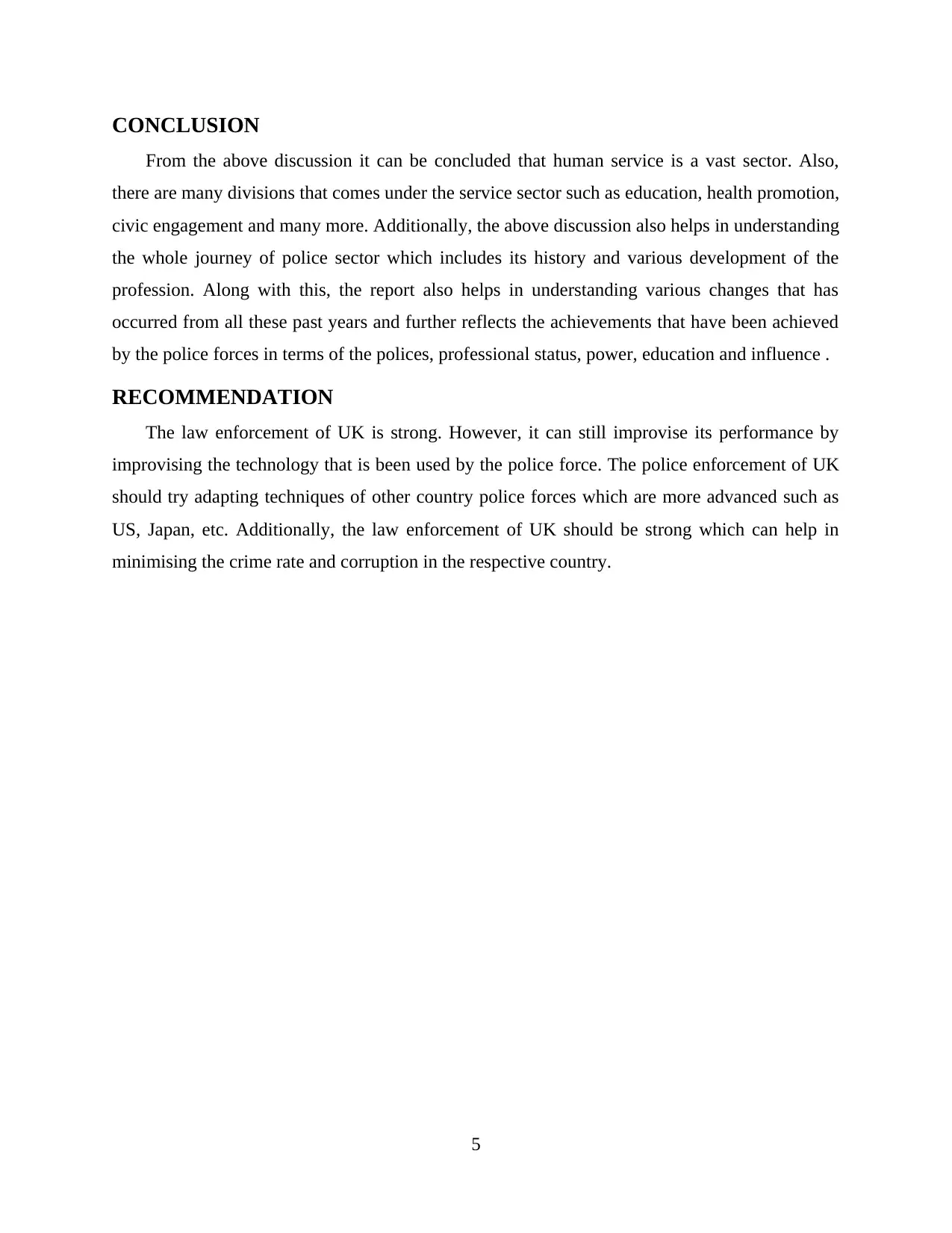
CONCLUSION
From the above discussion it can be concluded that human service is a vast sector. Also,
there are many divisions that comes under the service sector such as education, health promotion,
civic engagement and many more. Additionally, the above discussion also helps in understanding
the whole journey of police sector which includes its history and various development of the
profession. Along with this, the report also helps in understanding various changes that has
occurred from all these past years and further reflects the achievements that have been achieved
by the police forces in terms of the polices, professional status, power, education and influence .
RECOMMENDATION
The law enforcement of UK is strong. However, it can still improvise its performance by
improvising the technology that is been used by the police force. The police enforcement of UK
should try adapting techniques of other country police forces which are more advanced such as
US, Japan, etc. Additionally, the law enforcement of UK should be strong which can help in
minimising the crime rate and corruption in the respective country.
5
From the above discussion it can be concluded that human service is a vast sector. Also,
there are many divisions that comes under the service sector such as education, health promotion,
civic engagement and many more. Additionally, the above discussion also helps in understanding
the whole journey of police sector which includes its history and various development of the
profession. Along with this, the report also helps in understanding various changes that has
occurred from all these past years and further reflects the achievements that have been achieved
by the police forces in terms of the polices, professional status, power, education and influence .
RECOMMENDATION
The law enforcement of UK is strong. However, it can still improvise its performance by
improvising the technology that is been used by the police force. The police enforcement of UK
should try adapting techniques of other country police forces which are more advanced such as
US, Japan, etc. Additionally, the law enforcement of UK should be strong which can help in
minimising the crime rate and corruption in the respective country.
5
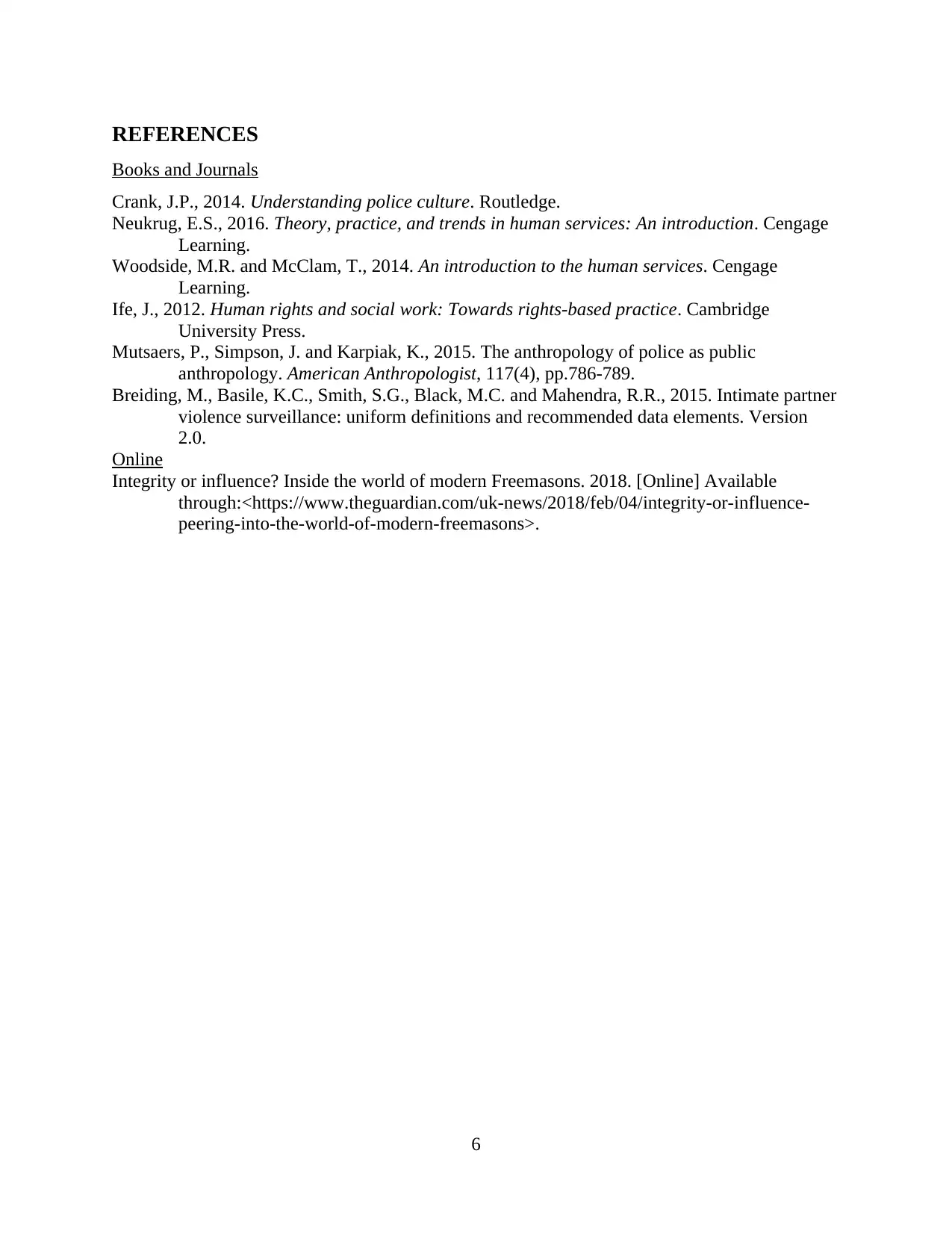
REFERENCES
Books and Journals
Crank, J.P., 2014. Understanding police culture. Routledge.
Neukrug, E.S., 2016. Theory, practice, and trends in human services: An introduction. Cengage
Learning.
Woodside, M.R. and McClam, T., 2014. An introduction to the human services. Cengage
Learning.
Ife, J., 2012. Human rights and social work: Towards rights-based practice. Cambridge
University Press.
Mutsaers, P., Simpson, J. and Karpiak, K., 2015. The anthropology of police as public
anthropology. American Anthropologist, 117(4), pp.786-789.
Breiding, M., Basile, K.C., Smith, S.G., Black, M.C. and Mahendra, R.R., 2015. Intimate partner
violence surveillance: uniform definitions and recommended data elements. Version
2.0.
Online
Integrity or influence? Inside the world of modern Freemasons. 2018. [Online] Available
through:<https://www.theguardian.com/uk-news/2018/feb/04/integrity-or-influence-
peering-into-the-world-of-modern-freemasons>.
6
Books and Journals
Crank, J.P., 2014. Understanding police culture. Routledge.
Neukrug, E.S., 2016. Theory, practice, and trends in human services: An introduction. Cengage
Learning.
Woodside, M.R. and McClam, T., 2014. An introduction to the human services. Cengage
Learning.
Ife, J., 2012. Human rights and social work: Towards rights-based practice. Cambridge
University Press.
Mutsaers, P., Simpson, J. and Karpiak, K., 2015. The anthropology of police as public
anthropology. American Anthropologist, 117(4), pp.786-789.
Breiding, M., Basile, K.C., Smith, S.G., Black, M.C. and Mahendra, R.R., 2015. Intimate partner
violence surveillance: uniform definitions and recommended data elements. Version
2.0.
Online
Integrity or influence? Inside the world of modern Freemasons. 2018. [Online] Available
through:<https://www.theguardian.com/uk-news/2018/feb/04/integrity-or-influence-
peering-into-the-world-of-modern-freemasons>.
6
⊘ This is a preview!⊘
Do you want full access?
Subscribe today to unlock all pages.

Trusted by 1+ million students worldwide
1 out of 6
Your All-in-One AI-Powered Toolkit for Academic Success.
+13062052269
info@desklib.com
Available 24*7 on WhatsApp / Email
![[object Object]](/_next/static/media/star-bottom.7253800d.svg)
Unlock your academic potential
Copyright © 2020–2025 A2Z Services. All Rights Reserved. Developed and managed by ZUCOL.

